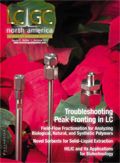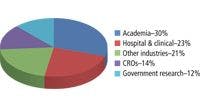SFC 2013: Meeting Review
LCGC North America
A review of the 7th International Symposium on Packed Column SFC (SFC 2013), which was held in Boston, Massachusetts, from July 10 to 12, 2013.
Larry Miller, Amgen, Cambridge, Massachusetts and Larry Taylor, Department of Chemistry, Virginia Tech, Blacksburg, Virginia
The 7th International Symposium on Packed Column SFC (SFC 2013) — dedicated to bringing scientists together to discuss the latest advances in supercritical fluid chromatography (SFC) — was held in Boston, Massachusetts, on July 10–12, 2013. The conference is organized annually by the Green Chemistry Group and alternates between the United States and Europe. The conference attracted more than 170 scientists from 10 countries, and 11 exhibitors displayed equipment and stationary phases for SFC use. The conference included 19 oral presentations, 36 poster presentations, and two vendor workshops. A short course dedicated to SFC theory and achiral, chiral, and preparative SFC was held before the conference. The program and many of the oral and poster presentations from SFC 2013 and previous SFC conferences can be found at www.greenchemistrygroup.org/index.html
Plenary Lectures
Each day of the conference began with a plenary lecture from a recognized expert in the field of supercritical fluids. Jerry King from Genesis (Arkansas) began the first day of the conference with a presentation titled "The Symbiosis Between SFE and SFC." King gave a history of supercritical fluid extraction (SFE) and discussed advances made over the past 30 years. One of the main highlights of his presentation was a discussion of SFE operated at higher pressures (1000 bar). Higher pressures have not been utilized for SFE processing until recently because of the high equipment costs. However, these have now been evaluated and implemented for a number of processes. Higher-pressure operation provides extract concentrates with enriched levels of active ingredients not viable at lower extraction pressures. Depending on the application, >1000-bar SFE processing and equipment costs can be competitive. A 1000-bar SFE plant is currently under construction in Hawaii, with an on-line date of January 2014.
The second day kicked off with a plenary lecture by the recipient of the first annual Averica Award: Bill Farrell of Pfizer, La Jolla (San Diego, California). Farrell reported on the use of SFC to solve analytical challenges of reaction optimization screens. These analyses can be difficult for two reasons: There is a wide array of organic solvents and catalysts; and the presence of both soluble and insoluble materials and the high complexity of the samples. Although high performance liquid chromatography–mass spectrometry (HPLC–MS) can work for these analyses, Farrell has found SFC provides higher resolution. The advantages of SFC relative to HPLC were highlighted by an assay developed to monitor reaction optimization for boronate chemistry. These products are notoriously unstable in water and exhibit rapid hydrolysis. The boronic acid degradant forms in situ on the column when performing HPLC with an aqueous mobile phase, whereas the product, starting material, and reaction by-products are well separated using SFC. In addition, no water is present in the mobile phase and in situ degradation is not observed, which produces accurate data. In the year since the switch from HPLC–MS to SFC in Farrell's laboratory, the number of reaction optimization samples being analyzed by SFC has increased nearly fivefold.
Analytical SFC
The main application of SFC remains purification, but the use of analytical SFC is increasing. This has been facilitated by the introduction of advanced SFC equipment allowing the use of smaller-particle-size stationary phases as well as offering limits of detection and sensitivity approaching those seen in HPLC. The opportunities possible with this new generation of equipment were evident in the presentation by Robert Campbell of the Dow Chemical Company (Michigan). Campbell reported on the use of high-efficiency SFC to solve separation difficulties associated with highly complex mixtures. Many of his examples involved polymer mixtures where higher efficiency SFC separations led to increased analytical information as well as drastically shorter separation time. The use of 1.7-µm columns for Triton-X100 analysis showed more than a 15-fold reduction in analysis time relative to a 5-µm column. Numerous examples demonstrated how the low pressure drop of SFC allows columns to be coupled that generate more than 100,000 plates for a 1.7-µm, 30-cm column. Campbell closed his talk with some requests for the next generation of analytical SFC equipment including lower extracolumn system volumes and higher pressure ratings.
Ruben De Pauw from Vrije Universiteit (Brussels, Belgium) presented a comparison of constant pressure and constant flow rate for gradient elution separations in SFC. Using simulated and experimental data, De Pauw demonstrated that working under constant pressure mode and optimal flow rates results in a 40% decrease in analysis time and higher peak capacity relative to the constant flow rate mode.
Ray McClain from Merck (Philadelphia, Pennsylvania) presented the results of an academic collaboration between Merck and Pusan National University (Busan, South Korea) concerning the design and synthesis of novel achiral stationary phases for SFC. The design of the stationary phases takes advantage of advances from over the past two decades: Exploration of amide and urea linkage lengths; and the introduction of a chiral center to move the basic aromatic ring out of plane with the linker, allowing simultaneous multipoint interactions. They synthesized 10 stationary phases and analyzed them using 28 test molecules. The analysis determined that simultaneous multipoint interactions do not have a significant impact on retention compared to their planar counterparts; positional substitution of pyridines has a dramatic impact on retention; and amide and urea linkages improve chromatographic performance relative to phases without hydrogen bonding capability.
Preparative SFC
For the past 20 years the main application of SFC has been the preparative resolution of enantiomers. Although SFC is diversifying into different areas, purification is expected to remain prominent because of the advantages over HPLC including speed, lower costs, and reduced solvent usage
Samples requiring SFC purification often exhibit poor solubility in carbon dioxide–based mobile phases, leading to processing difficulties and low productivity separations.
Kyung Gahm from Amgen (Los Angeles, California) discussed the evaluation of on-line coupling of SFE and SFC for preparative purification of low solubility materials. The sample was mixed with silica and packed into a column prior to the separation column. Material was injected by periodically pressurizing the sample column and placing it in series with the separation column. The use of this technique was illustrated for the purification of a sample mixture containing an insoluble starting material as well as a desired product that had poor solubility.
Rachel Schmidt of GlaxoSmithKline (GSK, Hertfordshire, UK) reported on lifecycle assessment work performed comparing SFC to HPLC for pharmaceutical purification. Data from the GSK purification group for the past three years showed a drastic decrease in solvent usage because the majority (97%) of the purifications are now performed by SFC. In 2012 the use of SFC resulted in savings of 190,000 kg CO2, 1.7 MJ energy, and more than 44,000 kg water. These savings represented a 90–93% reduction relative to HPLC. The transition to SFC has also resulted in reduced solvent costs for the laboratory, from $90/g purified in 2010 to $34/g purified in 2012.
SFC Theory and New Uses of SFC
The past five years has seen a large increase in theoretical research in many areas of SFC, and some of the latest research was presented during the conference. Carbon dioxide–based mobile phases exhibit higher compressibility relative to HPLC mobile phases, resulting in varying local velocity and a pressure gradient along the length of the column. In SFC both mobile-phase density and viscosity vary along the column.
Georges Guiochon of the University of Tennessee (Knoxville, Tennessee) presented a new theoretical approach to measure equilibrium isotherms in SFC. He showed that while advances are needed to improve precision of measurements, the isotherm measurement methods available and used in HPLC can be applied in SFC — provided the influence of the local pressure on the equilibrium parameters is taken into account.
Two talks focused on the effects of pressure drop and thermal conditions on efficiency in SFC. Donald Poe from the University of Minnesota Duluth (Duluth, Minnesota) presented experimental results from his study, and Krzystof Kaczmarski from the Rzeszów University of Technology (Rzeszów, Poland) discussed the modeling of SFC separations under different thermal environments. Multiple publications over the past 20 years have reported reduced efficiencies at low outlet pressures (<100 bar), and they have been attributed to radial temperature gradients. Poe has demonstrated that storing a column in still air versus a convective column oven or covering the column with insulation can allow excellent efficiency at low outlet pressure. He closed his talk with a proposal that operation at high pressures under zero heat conditions may be best for high performance SFC. Kaczmarski presented two original models to account for the behavior of SFC columns under different thermal environments. The first model showed good agreement between experimental and calculated pressure, temperature, and density along the column for different mobile-phase compositions. This model is best used for outlet pressures greater than 120 bar. The second model is best used for outlet pressure of 150 bar or larger.
Poster Sessions and Best Poster Awards
As with previous SFC meetings, many attendees chose to present their work in poster format. Topics covered all areas related to SFC including analytical and preparative SFC, stationary phase development, and evaluation. Awards consisting of cash prizes were given to the top two posters as judged by the Scientific Committee.
This year's winning poster was "Possibilities and Limitations of the Kinetic Plot Method in SFC" by Ruben De Pauw and coauthors of the Vrije Universiteit (Brussels, Belgium). The kinetic plot method allows an unbiased comparison of particle sizes, columns, and chromatographic systems in terms of analysis time and efficiency. The poster investigated the use of this method for SFC separations. The authors showed that by using the variable-length method the kinetic plot could be correctly constructed in SFC conditions. Although this method allows scaling with particle size, extrapolating to other pressure drops is not possible with this method because of the complex, nonlinear behavior of SFC.
The second place winner was "Optimal Column Geometry for High Kinetic Performance Supercritical Fluid Chromatography Using State-of-the-Art Instruments," by Alexandre Grand-Guillaume Perrenoud and coauthors from the University of Geneva (Geneva, Switzerland). This work investigated the use of sub-2-µm particles with the latest generation of SFC equipment. The author recommended the use of 100 mm × 3 mm or larger columns to avoid the extracolumn volumes of the current state-of-the-art equipment that impact efficiency.
SFC 2014
The 8th annual Symposium on Packed Column SFC (SFC 2014) will be held next autumn in Europe. The location and timing will coincide with SPICA 2014, allowing scientists to attend both meetings. Additional information on SFC 2014 will be posted as it becomes available on the Green Chemistry Group website: www.greenchemistrygroup.org
Larry Miller is with Amgen in Cambridge, Massachusetts.
Larry Taylor is with the Department of Chemistry at Virginia Tech in Blacksburg, Virginia.

Determining Enhanced Sensitivity to Odors due to Anxiety-Associated Chemosignals with GC
May 8th 2025Based on their hypothesis that smelling anxiety chemosignals can, like visual anxiety induction, lead to an increase in odor sensitivity, a joint study between the University of Erlangen-Nuremberg (Erlangen, Germany) and the Fraunhofer Institute for Process Engineering and Packaging (Freising, Germany) combined behavioral experiments, odor profile analysis by a trained panel, and instrumental analysis of odorants (gas chromatography-olfactometry) and volatiles (gas chromatography-mass spectrometry).
Investigating 3D-Printable Stationary Phases in Liquid Chromatography
May 7th 20253D printing technology has potential in chromatography, but a major challenge is developing materials with both high porosity and robust mechanical properties. Recently, scientists compared the separation performances of eight different 3D printable stationary phases.
Detecting Hyper-Fast Chromatographic Peaks Using Ion Mobility Spectrometry
May 6th 2025Ion mobility spectrometers can detect trace compounds quickly, though they can face various issues with detecting certain peaks. University of Hannover scientists created a new system for resolving hyper-fast gas chromatography (GC) peaks.

.png&w=3840&q=75)

.png&w=3840&q=75)



.png&w=3840&q=75)



.png&w=3840&q=75)








